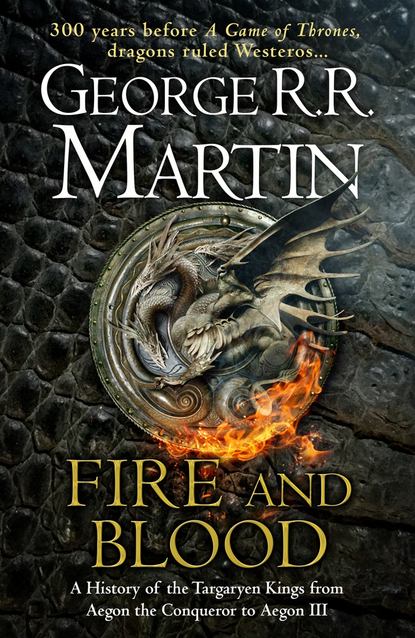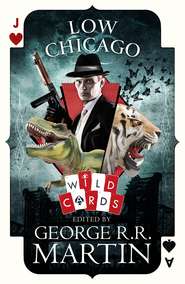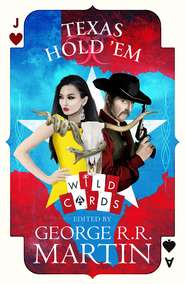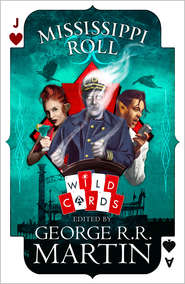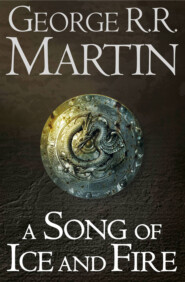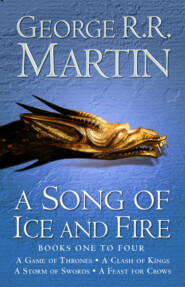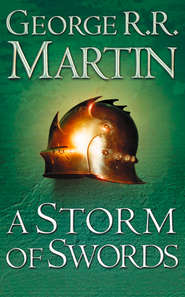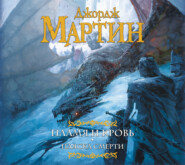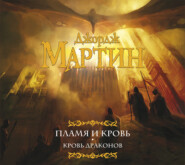По всем вопросам обращайтесь на: info@litportal.ru
(©) 2003-2024.
✖
Fire and Blood
Год написания книги
2019
Настройки чтения
Размер шрифта
Высота строк
Поля
Advised of their coming in his camp beside the Gods Eye, Aegon gathered his own strength and advanced to meet these new foes. He commanded only a fifth as many men as the Two Kings, and much of his strength was made up of men sworn to the riverlords, whose loyalty to House Targaryen was of recent vintage, and untested. With the smaller host, however, Aegon was able to move much more quickly than his foes. At the town of Stoney Sept, both his queens joined him with their dragons—Rhaenys from Storm’s End and Visenya from Crackclaw Point, where she had accepted many fervent pledges of fealty from the local lords. Together the three Targaryens watched from the sky as Aegon’s army crossed the headwaters of the Blackwater Rush and raced south.
The two armies came together amongst the wide, open plains south of the Blackwater, near to where the goldroad would run one day. The Two Kings rejoiced when their scouts returned to them and reported Targaryen numbers and dispositions. They had five men for every one of Aegon’s, it seemed, and the disparity in lords and knights was even greater. And the land was wide and open, all grass and wheat as far as the eye could see, ideal for heavy horse. Aegon Targaryen would not command the high ground, as Orys Baratheon had at the Last Storm; the ground was firm, not muddy. Nor would they be troubled by rain. The day was cloudless, though windy. There had been no rain for more than a fortnight.
King Mern had brought half again as many men to the battle as King Loren, and so demanded the honor of commanding the center. His son and heir, Edmund, was given the vanguard. King Loren and his knights would form the right, Lord Oakheart the left. With no natural barriers to anchor the Targaryen line, the Two Kings meant to sweep around Aegon on both flanks, then take him in the rear, whilst their “iron fist,” a great wedge of armored knights and high lords, smashed through Aegon’s center.
Aegon Targaryen drew his own men up in a rough crescent bristling with spears and pikes, with archers and crossbowmen just behind and light cavalry on either flank. He gave command of his host to Jon Mooton, Lord of Maidenpool, one of the first foes to come over to his cause. The king himself intended to do his fighting from the sky, beside his queens. Aegon had noted the absence of rain as well; the grass and wheat that surrounded the armies was tall and ripe for harvest … and very dry.
The Targaryens waited until the Two Kings sounded their trumpets and started forward beneath a sea of banners. King Mern himself led the charge against the center on his golden stallion, his son Gawen beside him with his banner, a great green hand upon a field of white. Roaring and screaming, urged on by horns and drums, the Gardeners and Lannisters charged through a storm of arrows down unto their foes, sweeping aside the Targaryen spearmen, shattering their ranks. But by then Aegon and his sisters were in the air.
Aegon flew above the ranks of his foes upon Balerion, through a storm of spears and stones and arrows, swooping down repeatedly to bathe his foes in flame. Rhaenys and Visenya set fires upwind of the enemy and behind them. The dry grasses and stands of wheat went up at once. The wind fanned the flames and blew the smoke into the faces of the advancing ranks of the Two Kings. The scent of fire sent their mounts into panic, and as the smoke thickened, horse and rider alike were blinded. Their ranks began to break as walls of fire rose on every side of them. Lord Mooton’s men, safely upwind of the conflagration, waited with their bows and spears, and made short work of the burned and burning men who came staggering from the inferno.
The Field of Fire, the battle was named afterward.
More than four thousand men died in the flames. Another thousand perished by sword and spear and arrow. Tens of thousands suffered burns, some so bad that they would remain scarred for life. King Mern IX was amongst the dead, together with his sons, grandsons, brothers, cousins, and other kin. One nephew survived for three days. When he died of his burns, House Gardener died with him. King Loren of the Rock lived, riding through a wall of flame and smoke to safety when he saw the battle lost.
The Targaryens lost fewer than a hundred men. Queen Visenya took an arrow in one shoulder, but soon recovered. As the dragons gorged themselves on the dead, Aegon commanded that the swords of the slain be gathered up and sent downriver.
Loren Lannister was captured the next day. The King of the Rock laid his sword and crown at Aegon’s feet, bent the knee, and did him homage. And Aegon, true to his promises, lifted his beaten foe back to his feet and confirmed him in his lands and lordship, naming him Lord of Casterly Rock and Warden of the West. Lord Loren’s bannermen followed his example, and so too did many lords of the Reach, those who had survived the dragonfire.
Yet the conquest of the west remained incomplete, so King Aegon parted from his sisters and marched at once for Highgarden, hoping to secure its surrender before some other claimant could seize it for his own. He found the castle in the hands of its steward, Harlan Tyrell, whose forebears had served the Gardeners for centuries. Tyrell yielded up the keys to the castle without a fight and pledged his support to the conquering king. In reward Aegon granted him Highgarden and all its domains, naming him Warden of the South and Lord Paramount of the Mander, and giving him dominion over all House Gardener’s former vassals.
It was King Aegon’s intent to continue his march south and enforce the submission of Oldtown, the Arbor, and Dorne, but whilst at Highgarden word of a new challenge came to his ears. Torrhen Stark, King in the North, had crossed the Neck and entered the riverlands, leading an army of savage northmen thirty thousand strong. Aegon at once started north to meet him, racing ahead of his army on the wings of Balerion, the Black Dread. He sent word to his two queens as well, and to all the lords and knights who had bent the knee to him after Harrenhal and the Field of Fire.
When Torrhen Stark reached the banks of the Trident, he found a host half again the size of his own awaiting him south of the river. Riverlords, westermen, stormlanders, men of the Reach … all had come. And above their camp Balerion, Meraxes, and Vhagar prowled the sky in ever-widening circles.
Torrhen’s scouts had seen the ruins of Harrenhal, where slow red fires still burned beneath the rubble. The King in the North had heard many accounts of the Field of Fire as well. He knew that the same fate might await him if he tried to force a crossing of the river. Some of his lords bannermen urged him to attack all the same, insisting that northern valor would carry the day. Others urged him to fall back to Moat Cailin and make his stand there on northern soil. The king’s bastard brother Brandon Snow offered to cross the Trident alone under cover of darkness, to slay the dragons whilst they slept.
King Torrhen did send Brandon Snow across the Trident. But he crossed with three maesters by his side, not to kill but to treat. All through the night messages went back and forth. The next morning, Torrhen Stark himself crossed the Trident. There upon the south bank of the Trident, he knelt, laid the ancient crown of the Kings of Winter at Aegon’s feet, and swore to be his man. He rose as Lord of Winterfell and Warden of the North, a king no more. From that day to this day, Torrhen Stark is remembered as the King Who Knelt … but no northman left his burned bones beside the Trident, and the swords Aegon collected from Lord Stark and his vassals were not twisted nor melted nor bent.
Now Aegon Targaryen and his queens parted company. Aegon turned south once again, marching toward Oldtown, whilst his two sisters mounted their dragons—Visenya for the Vale of Arryn and Rhaenys for Sunspear and the deserts of Dorne.
Sharra Arryn had strengthened the defenses of Gulltown, moved a strong host to the Bloody Gate, and tripled the size of the garrisons in Stone, Snow, and Sky, the waycastles that guarded the approach to the Eyrie. All these defenses proved useless against Visenya Targaryen, who rode Vhagar’s leathery wings above them all and landed in the Eyrie’s inner courtyard. When the regent of the Vale rushed out to confront her, with a dozen guards at her back, she found Visenya with Ronnel Arryn seated on her knee, staring at the dragon, wonder-struck. “Mother, can I go flying with the lady?” the boy king asked. No threats were spoken, no angry words exchanged. The two queens smiled at one another and exchanged courtesies instead. Then Lady Sharra sent for the three crowns (her own regent’s coronet, her son’s small crown, and the Falcon Crown of Mountain and Vale that the Arryn kings had worn for a thousand years), and surrendered them to Queen Visenya, along with the swords of her garrison. And it was said afterward that the little king flew thrice about the summit of the Giant’s Lance, and landed to find himself a little lord. Thus did Visenya Targaryen bring the Vale of Arryn into her brother’s realm.
Rhaenys Targaryen had no such easy conquest. A host of Dornish spearmen guarded the Prince’s Pass, the gateway through the Red Mountains, but Rhaenys did not engage them. She flew above the pass, above the red sands and the white, and descended upon Vaith to demand its submission, only to find the castle empty and abandoned. In the town beneath its walls, only women and children and old men remained. When asked where their lords had gone, they would only say, “Away.” Rhaenys followed the river downstream to Godsgrace, seat of House Allyrion, but it too was deserted. On she flew. Where the Greenblood met the sea, Rhaenys came upon the Planky Town, where hundreds of poleboats, fishing skiffs, barges, houseboats, and hulks sat baking in the sun, joined together with ropes and chains and planks to make a floating city, yet only a few old women and small children appeared to peer up at her as Meraxes circled overhead.
Finally the queen’s flight took her to Sunspear, the ancient seat of House Martell, where she found the Princess of Dorne waiting in her abandoned castle. Meria Martell was eighty years of age, the maesters tell us, and had ruled the Dornishmen for sixty of those years. She was very fat, blind, and almost bald, her skin sallow and sagging. Argilac the Arrogant had named her “the Yellow Toad of Dorne,” but neither age nor blindness had dulled her wits.
“I will not fight you,” Princess Meria told Rhaenys, “nor will I kneel to you. Dorne has no king. Tell your brother that.”
“I shall,” Rhaenys replied, “but we will come again, Princess, and the next time we shall come with fire and blood.”
“Your words,” said Princess Meria. “Ours are Unbowed, Unbent, Unbroken. You may burn us, my lady … but you will not bend us, break us, or make us bow. This is Dorne. You are not wanted here. Return at your peril.”
Thus queen and princess parted, and Dorne remained unconquered.
To the west, Aegon Targaryen met a warmer welcome. The greatest city in all of Westeros, Oldtown was ringed about with massive walls, and ruled by the Hightowers of the Hightower, the oldest, richest, and most powerful of the noble houses of the Reach. Oldtown was also the center of the Faith. There dwelt the High Septon, Father of the Faithful, the voice of the new gods on earth, who commanded the obedience of millions of devout throughout the realms (save in the North, where the old gods still held sway), and the blades of the Faith Militant, the fighting order the smallfolk called the Stars and Swords.
Yet when Aegon Targaryen and his host approached Oldtown, they found the city gates open and Lord Hightower waiting to make his submission. As it happened, when word of Aegon’s landing first reached Oldtown, the High Septon had locked himself within the Starry Sept for seven days and seven nights, seeking the guidance of the gods. He took no nourishment but bread and water, and spent all his waking hours in prayer, moving from one altar to the next. And on the seventh day, the Crone had lifted up her golden lamp to show him the path ahead. If Oldtown took up arms against Aegon the Dragon, His High Holiness saw, the city would surely burn, and the Hightower and the Citadel and the Starry Sept would be cast down and destroyed.
Manfred Hightower, Lord of Oldtown, was a cautious lord and godly. One of his younger sons served with the Warrior’s Sons, and another had only recently taken vows as a septon. When the High Septon told him of the vision vouchsafed him by the Crone, Lord Hightower determined that he would not oppose the Conqueror by force of arms. Thus it was that no men from Oldtown burned on the Field of Fire, though the Hightowers were bannermen to the Gardeners of Highgarden. And thus it was that Lord Manfred rode forth to greet Aegon the Dragon as he approached, and to offer up his sword, his city, and his oath. (Some say that Lord Hightower also offered up the hand of his youngest daughter, which Aegon declined politely, lest it offend his two queens.)
Three days later, in the Starry Sept, His High Holiness himself anointed Aegon with the seven oils, placed a crown upon his head, and proclaimed him Aegon of House Targaryen, the First of His Name, King of the Andals, the Rhoynar, and the First Men, Lord of the Seven Kingdoms, and Protector of the Realm. (“Seven Kingdoms” was the style used, though Dorne had not submitted. Nor would it, for more than a century to come.)
Only a handful of lords had been present for Aegon’s first coronation at the mouth of the Blackwater, but hundreds were on hand to witness his second, and tens of thousands cheered him afterward in the streets of Oldtown as he rode through the city on Balerion’s back. Amongst those at Aegon’s second coronation were the maesters and archmaesters of the Citadel. Perhaps for that reason, it was this coronation, rather than the Aegonfort crowning on the day of Aegon’s landing, that became fixed as the start of Aegon’s reign.
Thus were the Seven Kingdoms of Westeros hammered into one great realm, by the will of Aegon the Conqueror and his sisters.
Many thought that King Aegon would make Oldtown his royal seat after the wars were done, whilst others thought he would rule from Dragonstone, the ancient island citadel of House Targaryen. The king surprised them all by proclaiming his intent to make his court in the new town already rising upon the three hills at the mouth of the Blackwater Rush, where he and his sisters had first set foot on the soil of Westeros. King’s Landing, the new town would be called. From there Aegon the Dragon would rule his realm, holding court from a great metal seat made from the melted, twisted, beaten, and broken blades of all his fallen foes, a perilous seat that would soon be known through all the world as the Iron Throne of Westeros.
Reign of the Dragon
The Wars of King Aegon I
The long reign of King Aegon I Targaryen (1 AC–37 AC) was by and large a peaceful one … in his later years, especially. But before the Dragon’s Peace, as the last two decades of his kingship were later called by the maesters of the Citadel, came the Dragon’s wars, the last of which was as cruel and bloody a conflict as any ever fought in Westeros.
Though the Wars of Conquest were said to have ended when Aegon was crowned and anointed by the High Septon in the Starry Sept of Oldtown, not all of Westeros had yet submitted to his rule.
In the Bite, the lords of the Three Sisters had taken advantage of the chaos of Aegon’s Conquest to declare themselves a free nation and crown Lady Marla of House Sunderland their queen. As the Arryn fleet had largely been destroyed during the Conquest, the king commanded his Warden of the North, Torrhen Stark of Winterfell, to end the Sistermen’s Rebellion, and a northern army departed from White Harbor on a fleet of hired Braavosi galleys, under the command of Ser Warrick Manderly. The sight of his sails, and the sudden appearance of Queen Visenya and Vhagar in the skies above Sisterton, took the heart out of the Sistermen; they promptly deposed Queen Marla in favor of her younger brother. Steffon Sunderland renewed his fealty to the Eyrie, bent the knee to Queen Visenya, and gave his sons over as hostages for his good behavior, one to be fostered with the Manderlys, the other with the Arryns. His sister, the deposed queen, was exiled and imprisoned. After five years, her tongue was removed, and she spent the remainder of her life with the silent sisters, tending to the noble dead.
On the other side of Westeros, the Iron Islands were in chaos. House Hoare had ruled the ironmen for long centuries, only to be extinguished in a single night when Aegon unleashed Balerion’s fires on Harrenhal. Though Harren the Black and his sons perished in those flames, Qhorin Volmark of Harlaw, whose grandmother had been a younger sister of Harren’s grandsire, declared himself the rightful heir “of the black line,” and assumed the kingship.
Not all ironborn accepted his claim, however. On Old Wyk, under the bones of Nagga the Sea Dragon, the priests of the Drowned God placed a driftwood crown on the head of one of their own, the barefoot holy man Lodos, who proclaimed himself the living son of the Drowned God and was said to be able to work miracles. Other claimants arose on Great Wyk, Pyke, and Orkmont, and for more than a year their adherents battled one another on land and sea. It was said that the waters between the islands were so choked with corpses that krakens appeared by the hundreds, drawn by the blood.
Aegon Targaryen put an end to the fighting. He descended on the islands in 2 AC, riding Balerion. With him came the war fleets of the Arbor, Highgarden, and Lannisport, and even a few longships from Bear Island dispatched by Torrhen Stark. The ironmen, their numbers diminished by a year of fratricidal war, put up little resistance … indeed, many hailed the coming of the dragons. King Aegon slew Qhorin Volmark with Blackfyre, but allowed his infant son to inherit his father’s lands and castle. On Old Wyk, the priest-king Lodos, purported son of the Drowned God, called upon the krakens of the deep to rise and drag down the invaders’ ships. When that failed to happen, Lodos filled his robes with stones and walked into the sea, “to seek my father’s counsel.” Thousands followed. Their bloated, crab-eaten bodies washed up on the shores of Old Wyk for years to come.
Afterward, the issue arose as to who should rule the Iron Islands for the king. It was suggested that the ironmen be made vassals of the Tullys of Riverrun or the Lannisters of Casterly Rock. Some even urged that they be given over to Winterfell. Aegon listened to each claim, but in the end decided that he would allow the ironborn to choose their own lord paramount. To no one’s surprise, they chose one of their own: Vickon Greyjoy, Lord Reaper of Pyke. Lord Vickon did homage to King Aegon, and the Dragon departed with his fleets.
Greyjoy’s writ extended only to the Iron Islands, however; he renounced all claim to the lands House Hoare had seized upon the mainland. Aegon granted the ruined castle of Harrenhal and its domains to Ser Quenton Qoherys, his master-at-arms on Dragonstone, but required him to accept Lord Edmyn Tully of Riverrun as his liege lord. The new-made Lord Quenton had two strong sons and a plump grandson to assure the succession, but as his first wife had been carried off by spotted fever three years earlier, he further agreed to take one of Lord Tully’s daughters as his bride.
With the submission of the Three Sisters and the Iron Islands, all of Westeros south of the Wall was now ruled by Aegon Targaryen, save Dorne alone. So it was to Dorne that the Dragon next turned his attention. Aegon first attempted to win the Dornishmen with words, dispatching a delegation of high lords, maesters, and septons to Sunspear to treat with Princess Meria Martell, the so-called Yellow Toad of Dorne, and persuade her of the advantages of joining her realm to his. Their negotiations continued for the best part of a year, but achieved nothing.
The start of the First Dornish War is generally fixed at 4 AC, when Rhaenys Targaryen returned to Dorne. This time she came with fire and blood, just as she had threatened. Riding Meraxes, the queen descended out of a clear blue sky and set the Planky Town ablaze, the fires leaping from boat to boat until the whole mouth of the Greenblood was choked with burning flotsam, and the pillar of smoke could be seen as far away as Sunspear. The denizens of the floating town took to the river for refuge from the flames, so fewer than a hundred died in the attack, and most of those from drowning rather than dragonfire. But first blood had been shed.
Elsewhere, Orys Baratheon led one thousand picked knights up the Boneway, whilst Aegon himself marched through the Prince’s Pass at the head of an army thirty thousand strong, led by near two thousand mounted knights and three hundred lords and bannermen. Lord Harlan Tyrell, the Warden of the South, was heard to say that they had more than enough power to smash any Dornish army that tried to stand before them, even without Aegon and Balerion.
No doubt he had the right of that, but the issue was never proved, for the Dornishmen never offered battle. Instead they withdrew before King Aegon’s host, burning their crops in the field and poisoning every well. The invaders found the Dornish watchtowers in the Red Mountains slighted and abandoned. In the high passes, Aegon’s vanguard found its way barred by a wall of sheep carcasses, shorn of all wool and too rotted to eat. The king’s army was already running short of food and fodder by the time they emerged from the Prince’s Pass to face the Dornish sands. There Aegon divided his forces, sending Lord Tyrell south against Uthor Uller, Lord of the Hellholt, whilst he himself turned eastward, to besiege Lord Fowler in his mountain fastness Skyreach.
It was the second year of autumn, and winter was thought to be close at hand. In that season, the invaders hoped, the heat in the deserts would be less, water more plentiful. But the Dornish sun proved unrelenting as Lord Tyrell marched toward Hellholt. In such heat, men drink more, and every waterhole and oasis in the army’s path had been poisoned. Horses began to die, more every day, followed by their riders. The proud knights discarded their banners, their shields, their very armor. Lord Tyrell lost a quarter of his men and almost all his horses to the Dornish sands, and when at last he reached the Hellholt, he found it abandoned.
Orys Baratheon’s attack fared little better. His horses struggled on the stony slopes of the narrow, twisting passes, but many balked completely when they reached the steepest sections of the road, where the Dornish had chiseled steps into the mountains. Boulders rained down on the Hand’s knights from above, the work of defenders the stormlanders never saw. Where the Boneway crossed the river Wyl, Dornish archers suddenly appeared as the column was making its way across a bridge, and arrows rained down by the thousands. When Lord Orys ordered his men to fall back, a massive rockfall cut off their retreat. With no way forward and no way back, the stormlanders were butchered like hogs in a pen. Orys Baratheon himself was spared, along with a dozen other lords thought worth the ransom, but they found themselves captives of Wyl of Wyl, the savage mountain lord called Widow-lover.
King Aegon himself had more success. Marching eastward through the foothills, where runoff from the heights provided water and game was plentiful in the valleys, he took the castle Skyreach by storm, won Yronwood after a brief siege. The Lord of the Tor had recently died, and his steward surrendered without a fight. Farther east, Lord Toland of Ghost Hill sent forth his champion to challenge the king to single combat. Aegon accepted and slew the man, only to discover afterward that he had not been Toland’s champion, but his fool. Lord Toland himself was gone.
As was Meria Martell, the Princess of Dorne, when King Aegon descended upon Sunspear on Balerion, to find his sister Rhaenys there before him. After burning the Planky Town, she had taken Lemonwood, Spottswood, and Stinkwater, accepting obeisances from old women and children, but nowhere finding an actual enemy. Even the shadow city outside the walls of Sunspear was half-deserted, and none of those who remained would admit to any knowledge of the whereabouts of the Dornish lords and princess. “The Yellow Toad has melted into the sands,” Queen Rhaenys told King Aegon.
Aegon’s answer was a declaration of victory. In the great hall at Sunspear, he gathered together what dignitaries remained and told them that Dorne was now part of the realm, that henceforth they would be his leal subjects, that their former lords were rebels and outlaws. Rewards were offered for their heads, particularly that of the Yellow Toad, Princess Meria Martell. Lord Jon Rosby was named Castellan of Sunspear and Warden of the Sands, to rule Dorne in the king’s name. Stewards and castellans were named for all the other lands and castles the Conqueror had taken. Then King Aegon and his host departed back the way they had come, west along the foothills and through the Prince’s Pass.
They had hardly reached King’s Landing before Dorne erupted behind them. Dornish spearmen appeared from nowhere, like desert flowers after a rain. Skyreach, Yronwood, the Tor, and Ghost Hill were all recaptured within a fortnight, their royal garrisons put to the sword. Aegon’s castellans and stewards were allowed to die only after long torment. It was said that the Dornish lords had a wager over who could keep their captive alive the longest whilst dismembering them. Lord Rosby, Castellan of Sunspear and Warden of the Sands, had a kinder end than most. After the Dornishmen swarmed in from the shadow city to retake the castle, he was bound hand and foot, dragged to the top of the Spear Tower, and thrown from a window by none other than the aged Princess Meria herself.





